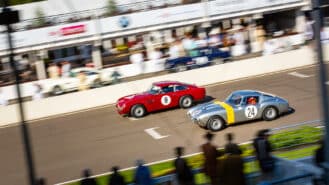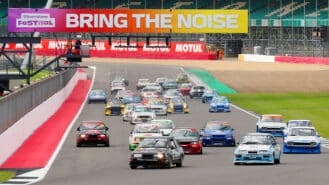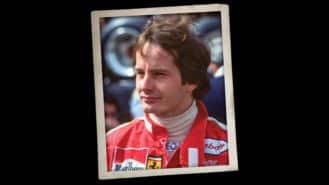
Watch now: 2023 Goodwood Revival live stream, Day 3
Live-stream all of the racing action from the 2023 Goodwood Revival: plus full schedule for the weekend
Long before the Bathurst 12 Hours, there was – and still is – the fabled Bathurst 1000. As part of ’80s month, we recap the wholly controversial 1987 race
Bathurst, steeped in history and lining the peak of Mount Panorama, is a fitting site of pilgrimage. The product of a late 1800s Australian gold rush, the city of fewer than 40,000 attracts a parochial crowd of up to 200,000 for the Bathurst 1000.
Some of the world’s best GT cars will tackle the Mountain for 12 hours this weekend, but before 1991 it was solely the domain of the tin-tops of the 1000.
In 1987, the Bathurst 1000 formed the eighth round of the now-defunct World Touring Car Championship, and the race was to take place on a track lengthened by a kink (the Caltex Chase) at the end of the Conrod Straight – a reaction to the death of Mike Burgmann in ’86.
But this round was to be the final time that the Bathurst 1000 was included in the WTCC as it operated solely in Europe for the following year, and the highly controversial manner in which the race was conducted was emblematic of the behaviour by manufacturers fighting for the WTCC title.
The battle for supremacy between Ford and BMW had erupted, and the $6,000 entry fee required to score points in the series had only proved a catalyst for the manufacturers’ dirty tricks, and, plainly speaking, conceited efforts to win.
The bar was set at sea level for the opening round at Monza, as all of the works BMW M3s were disqualified – due to weight stripping from the bootlids and roof (50 kilograms worth) – with the works Ford Sierras following suit, having swapped out their Weber electronics for non-homologated Bosch modifications. Allan Moffat and John Harvey took victory at Monza in their Holden Commodore after all six cars ahead of them were disqualified.
Bathurst, seven rounds later, continued in the same way. Indeed, the report in the November 1987 issue of Motor Sport put it succinctly: ‘The annual Bathurst saloon car race ended on somewhat of a low note this year amidst a mass of controversy.’
Protests raged from the pitlane before the race at Bathurst, with the Texaco-livered Eggenberger Ford Sierra Cosworth RS500s attracting suspicion due to their modified front bodywork. Three-time Le Mans winner Klaus Ludwig took pole in his Eggenberger Ford with team-mates Steve Soper/Pierre Dieudonné in third. This was Ford’s first pole at Bathurst for 11 years.
Adding to the frenzy, Ludwig now had Klaus Niedzwiedz as his team-mate – the no 12 car was withdrawn after qualifying.
According the ‘Legend and Controversy’ report at the time, A total of 161 laps were on the cards for the race, and the Fords of Soper/Pierre Dieudonné and [Klaus] Niedzwiedz/Ludwig led from the start. The pairing came under constant pressure throughout but managed to hold off any serious challenges to take the spoils.
Australian heroes Peter Brock/Peter MacLeod/David Parsons gave chase throughout with their Holden Commodore, but could not stop the Ford onslaught. BMW’s hopes lay with Roberto Ravaglia/Markus Oestreich/Roland Ratzenberger, but came to nought when they were forced to retire with engine problems.
It seemed a standard chase to the finish line, in a race dominated by the Texaco Fords for seven hours, with Soper and Dieudonné taking the chequered flag.
In third was eight-time Bathurst 1000 winner Peter Brock who drove alongside Peter McLeod and David Parsons, in their HDT Racing Holden VL Commodore. Brock’s engine blew up after 34 laps and he was forced to move to the second team car, finishing third. Brock had failed to qualify for the top 10 shootout for the first time, and started 20th.
The report concluded: ‘After the race there was further dispute, with fuel samples taken from the winning Fords and sent away for analysis. They later proved to be legal.’
That was far from the end of the story, however. Rumours began to circulate around the paddock that the dominant Fords were illegally set up, and though the fuel allegations were unfounded, victory was not to be for the Texaco-liveried pair.
Six months later, after the FIA’s court of appeals brushed aside the red tape and came to a conclusion, it turned out that the Ford Sierras of team boss Rudi Eggenberger had wheel arches much too big; the one-two win was not to be.
As a result, Brock had taken a record ninth Bathurst 1000 victory alongside Parsons and McLeod for the Holden Dealer Team from an improbable position, having started 20th, against the polished European imitators. Even more so, considering that he had switched to the second car after 34 laps of racing.
Through the pounding rain, his car bounding over the bumps of Bathurst, Brock had unknowingly been driving towards a victory the whole time.
Holden chief Alan Gow described events candidly, including the origins of the ‘second’ Holden in which Brock took victory, in the December 2016 Motor Sport podcast.
“We went [to Bathurst] with two old knackered cars. One was less knackered than the other to be honest, but they had old bits in it, we didn’t have any parts. On the Saturday night after qualifying we were going round buying fan belts and hoses and things off other team’s and exchanging them for what we call slabs of beer, because one of our sponsors was a brewery.
“Our team manager Graham would be walking round with a dozen bottles of beer, exchanging these for the car parts we needed for the next day, for brake pads and brake discs and stuff.
“I’ve got to tell you it’s the best form of currency you could ever get in a paddock, because if you gave them a cheque they’d go ‘no thank you’ but if you offered them beer… ‘here, have what you want.’
“We then equipped all our cars with what we could do, and then during the race the Eggenberger Sierras walked away with it and we came third and at the end of the race or subsequent to that they got thrown out on a technicality – cheating German bastards…”
In 1985, Brock had been testing a device for the VL Director known as the ‘Energy Polarizer’, which contained crystals and magnets in an arbitrary arrangement, a device which he claimed improved the performance of the vehicles. The relationship between Brock and Holden collapsed soon after – more on that in later in ‘80s month…
In 2010, would-be winner Niedzwiedz, who went on to take victory at the Nürburgring 24 Hours twice, told Australia’s motoring.com.au that the cheating allegations at Bathurst in ‘87 were: “All bullshit. The whole thing was a political problem, because BMW and Ford were trying very hard to get the championship title, and BMW had some parts that were not really legal and the Ford had some parts that were not really legal, but this was in every championship race.
“But finally, when we got to Australia, some of the Australian Ford Sierras didn’t have these parts, and so then they [BMW] made the protest. We lost the points and the win.”
He claimed that Brock and the other Australian drivers were “upset…because we were very comfortable in front of them. I don’t think it was illegal… sometimes the rules are open to interpretation.”
On Brock and the Australian contingency, he said, “They were really friendly. In the race car they are really little devils but outside the car they were always very friendly.”
Brock died on September 8 2006 while competing on the Targa West rally, his legacy inseparable from Bathurst and Holden alike.

Live-stream all of the racing action from the 2023 Goodwood Revival: plus full schedule for the weekend

Don't a miss a moment of the Silverstone Festival with a live stream of all this week's on-track action. Plus: a schedule of all 20 races celebrating the best of the circuit's 75 years

With races, titles and even careers on the line, F1 drivers will go above and beyond in search of success — no matter what the pain. Here are nine incredible stories

https://youtu.be/P-AHASG5Ddc Gilles Villeneuve's wife, Joann, has paid tribute to him as a true racer who sought out the very edge of performance, in a video clip released to commemorate the…